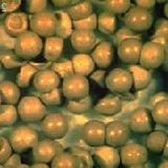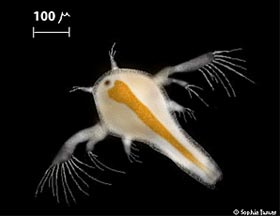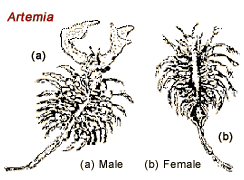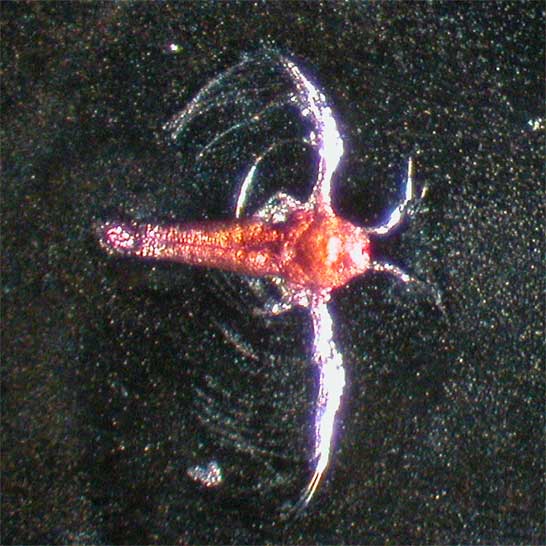Objective:
Here is an excellent experiment for a high school biology class demonstrating phototaxis (light attraction) and geotaxis (movement using Earth's gravity for orientation) in brine shrimp nauplii.
Although this presentation was designed for high school students, it can be modified for use in middle school.
Table of Contents
A Demonstration of Photo- and Geotaxes in Nauplii of Artemia Salina
By Daniel C. Koblick
Illinois Institute of Technology
5436 S. East View Park
#1 Life Sciences Building
Chicago, IL 60615
3101 S. Dearborn
Chicago, IL 60616
Overview
Students are presented with an easily observed orientation behavior of small crustaceans with respect to light and gravity. They are then given some description of the habitat and feeding behavior of the organisms being studied, and encouraged to relate the phenomena observed to the needs of the organisms in terms of adaptation.
Materials Needed
- 1 plastic shoe box with lid
- 1 or 2 liters of 4% NaCl
- A vial of brine shrimp (Artemia salina) eggs
- 1 siphon, consisting of a two-foot length of india rubber tubing with six-inch segments of glass tubing inserted in each end
- 2 wire pinch clamps
- 1 one-liter flask (a clean milk carton will do)
- A 100 ml graduate cylinder
- 1 glass tube, about eight inches long and of approx. one cm internal diameter
- 2 black rubber stoppers to fit above tube (Size 00)
Procedure: Hatching of Brine Shrimp Eggs

Brine shrimp eggs are available from tropical fish dealers. Purchasing in quantity (1/2 to 1 lb.) greatly reduces the unit price.
Each egg is as small as a grain of fine sand. A teaspoonful contains many thousands of eggs. The eggs will remain viable for several years if kept cool and dry.
If placed in a 2% to 4% salt solution, the eggs will hatch into tiny larvae known as nauplii (singular: nauplius). Do not use iodized salt, nor reagent grade salt; best results are obtained using sea salt, which is usually available in the gourmet section of your supermarket. A 4% salt solution is easily made up by making a saturated solution (add about 8 ounces of salt to two cups of water in a quart jar, agitate vigorously, and allow excess salt to settle), and diluting 100 ml of the saturated supernatant solution to one quart with water. (If you use tap water, allow it to stand overnight before use to get rid of the chlorine with which it has been treated.)
The best way of obtaining nauplii free of unhatched eggs and dead larvae (large numbers of eggs do not hatch, and many more die within minutes of emergence from the egg), is to fill a transparent plastic shoe box with 4% salt solution to a height of 1 to 11/2 inches, raise one end of the box about 1/2 inch by placing a wedge under it (so that the depth varies as it does in a swimming pool), and sprinkle about 1/2 teaspoonful of dry eggs over the surface.
If this is done gently, the eggs will float on the surface. Penetration of the salt solution into the eggs initiates development. Oxygen is required, and this is obtained directly from the air by the floating eggs. At room temperature, nauplii will emerge about 36 hours after wetting; at 30°C, emergence time is about 24 hours.
If the boxes are not disturbed during this period, unhatched eggs remain on the surface, and the rapidly swimming nauplii are found in the solution. These can be separated by siphoning the bulk of the solution into a beaker or other container.
After a short time, the nauplii will sink to the bottom of the vessel (this behavior is called a positive geotaxis), and a concentrated suspension of them can be made by transferring them to a test tube by means of a dropper pipette.
Demonstration of Phototaxis

Stopper one end of the glass tube and, holding the tube vertically, transfer the concentrated suspension of nauplii to the tube. Fill to the top with salt solution and stopper the upper end in such a way as to exclude all air bubbles. This can be done by holding a fine pin in the open end of the glass tube while introducing the stopper. The pin distorts the stopper and provides a pathway for excess solution and air to escape when the stopper is pushed into the tube; if the pin is then carefully pulled out (holding the stopper in place), no air bubbles will be trapped in the tube.
Invert the tube a few times to spread the nauplii evenly and place it on a horizontal surface. Direct the beam from a penlight or small flashlight on one end of the glass tube and cover the remainder of the tube with a paper towel. After a few minutes, almost all of the nauplii will be found at the lit end of the tube.
If the opposite end of the tube is then illuminated, the nauplii will again move to the illuminated end. (Because of reflections of light in the glass tube, not all the nauplii move to the point of greatest illumination; some will remain in the body of the tube. If a round-bottomed test tube had been used for this demonstration, a large number of nauplii would be found at the center of curvature of the semi- spheroidal part of the tube. This is because the bottom acts as a crude lens, concentrating the light at its focal point.)
Questions for General Discussion
- Beside the light gradient, what other gradients might be present in the tube?
(Gravitational gradient, chemical gradients of oxygen, carbon dioxide, excretory products of the nauplii themselves.) - In what ways did the experiment try to minimize the effects of these other gradients?
(Equal distribution of artemia at the beginning of the experiment, horizontal light gradient compared to vertical gravitational gradient, exclusion of air bubble.) - Of what use is this built-in response to the nauplii?
- Why does the unpurified sea salt produce better yields of nauplii than purified table salt or iodized salt?
Background
 |
The brine shrimp lives in salt swamps such as those often found inland of the dunes at the seashore, in man-made evaporation ponds used to obtain salt from the ocean, and in salt lakes such as those found in the intermountain desert region of the western United States. (Multicultural note: large salt water lakes are found in many parts of the world. One of the largest of these is the Caspian Sea, into which the famous Volga River flows.)

Few other organisms can tolerate such a high concentration of salt as is found in these locales. Sea water varies from about 2.9% to 3.5% salt, depending on the latitude and the time of year.
The Great Salt Lake, in northern Utah, undergoes long-term variations in salt content;
but since records have been kept, it has varied erratically between 25% and 35%. Adult brine shrimp can tolerate a salt content of as much as 50%. Since few organisms can grow at such high concentrations as that found in the Great Salt Lake, brine shrimp from this locale do not have much selection in the way of food. They live almost entirely on the photosynthetic green alga (singular of algae) Dunaliella.
Like many other primitive aquatic plants, this organism is attracted to light, rising to the surface in the daytime, and sinking at night. The positive phototaxis of Artemia keeps it at the same depth as its prey.
